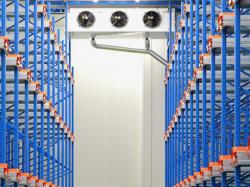End-To-End Integrated Services To Propel Global Refrigerated Warehousing Market, Says Technavio
July 12, 2016 | 4 min to read

LONDON — According to the latest research report released by Technavio, the global refrigerated warehousing market is expected to record a CAGR of more than 14% until 2020.
This report titled ‘Global Refrigerated Warehousing Market 2016-2020‘, provides an in-depth analysis of the market in terms of revenue and emerging trends. For calculating the market size, this report considers revenues generated from the commercial sales of stationery supplies to educational institutes.
Request sample report: http://bit.ly/29fREB5
“Several cold chain service providers have recently started to offer end-to-end integrated services to end-users in the global refrigerated warehousing market. They are providing cold chain management services to customers and participating in their decision-making processes. Many service providers offer end-to-end cold chain management services like inventory management, order scheduling, order forecasting, warehousing, and delivery management,” said Jhansi Mary, one of Technavio’s lead industry analysts for warehousing and storage.
Some of the other driving forces behind the growth of the global refrigerated warehousing market are as follows:
- Rise in trade of frozen food and sea food products
- Need to reduce food wastage
- Growth of organized retail sector
Rise in trade of frozen food and sea food products
The demand for seafood continues to increase globally, and the significant population growth in China, India, and Brazil is an important demand driver in the frozen fish and seafood industry. Increased demand for seafood has led to a rise in its import and exports within countries, which required cold storage and transportation. China and Norway were the largest exporters of seafood in 2015. China's exports amounted to $20 billion, and Norway exported $10 billion worth of seafood products. While China exported to almost all countries, Norway's exports were mostly to European nations. Fresh salmon constituted the majority of Norway's fish and seafood exports. We estimate that China's exports will grow at a CAGR of 15.68% over the forecast period. The European Union was the largest importer of seafood, worth USD 26 billion. The US and Japan followed, with seafood imports by the US amounting to USD 19 billion in 2015.
Need to reduce food wastage
According to United Nations Environment Programme (UNEP) and World Resources Institute (WRI) about one-third of the food produced every year is wasted. Fruits and vegetables wasted about 25% at the production level. In addition, perishable food products are often exposed to fluctuating temperatures during transit and handling, which adds to the wastage. The global population is expected to increase at a rapid pace in the future, which is expected to increase the demand for food products. Based on statistics, in 2015 the number of people suffering from malnutrition or starvation was about 956 million worldwide. Therefore, because of the increase in the global population and the food wastage, the need for effective cold chains is expected to increase substantially in the future. Therefore, the increased need to reduce the food wastage is one of the key drivers contributing to the growth of the market.
Growth of organized retail sector
Organized retail refers to modern retailing wherein a licensed retailer sells several goods belonging to different categories. It is the modern form of retail or chain stores that are owned or franchised by a central store or entity. The stores are organized and use better store systems technology, including better refrigeration, than traditional/unorganized retail stores and provide consumers with convenience and foods that are safe to consume. Organized retail formats include supermarkets, hypermarkets, forecourt retailers, discounters, and convenience stores. Nowadays, an increasing number of consumers are purchasing grocery items, including frozen and chilled food from organized retail stores. APAC is witnessing a steady increase in the number of modern retail stores. With the growth of the organized retail sector and the increased consumer demand for frozen and chilled food, demand for cold chains has increased and is expected to increase further during the forecast period.
Browse related reports
- Cold Chain Logistics Market in India 2015-2019
- Cold Chain Logistics Market in North America 2015-2019
- Global Refrigerated Transportation Market 2016-2020
- Global Perishable Goods Transportation Market 2016-2020
Do you need a report on a market in a specific geographical cluster or country but can’t find what you’re looking for? Don’t worry, Technavio also takes client requests. Please contact enquiry@technavio.com with your requirements and our analysts will be happy to create a customized report just for you.
About Technavio
Technavio is a leading global technology research and advisory company. The company develops over 2000 pieces of research every year, covering more than 500 technologies across 80 countries. Technavio has about 300 analysts globally who specialize in customized consulting and business research assignments across the latest leading edge technologies.
Technavio analysts employ primary as well as secondary research techniques to ascertain the size and vendor landscape in a range of markets. Analysts obtain information using a combination of bottom-up and top-down approaches, besides using in-house market modeling tools and proprietary databases. They corroborate this data with the data obtained from various market participants and stakeholders across the value chain, including vendors, service providers, distributors, re-sellers, and end-users.
Source: Technavio
